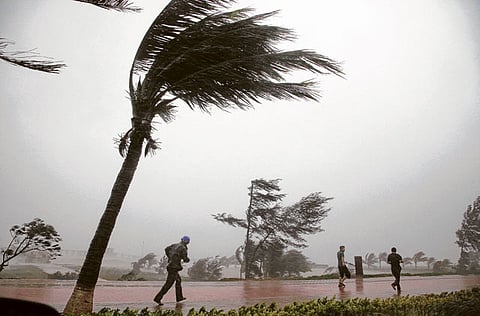Typhoon Nesat arrives in China
Hainan island on lockdown as storm which killed at least 35 in philippines strikes

Hong Kong: A powerful typhoon arrived in southern China yesterday after skirting Hong Kong and bringing death and widespread flooding to the Philippines earlier this week.
Typhoon Nesat made landfall on the eastern tip of China's Hainan island at 2.30pm, the official Xinhua news agency said.
Hainan authorities closed schools, suspended ferry services and recalled fishing boats as the storm made its way across the South China Sea from the Philippines, where it killed 35 people and left another 45 missing. Some 67 flights were cancelled at the island's two airports, Xinhua said.
The storm swept past Hong Kong earlier in the day, forcing the stock market to suspend trading and shops and businesses to close but causing little damage. The Asian financial centre's normally bustling streets were eerily quiet, with few people venturing outside to brave the rain and fierce winds.
Injuries
Two people were injured when bamboo scaffolding was blown over and collapsed onto a taxi, while a man was injured by a falling tree, local broadcaster RTHK said. A barge ripped free from its moorings in the rough seas slammed into a seawall on Hong Kong Island, forcing some nearby apartments to be evacuated, news reports said.
Local broadcaster Cable TV showed footage of tour groups from mainland China who were stranded after cross-border ferry services were suspended. At Hong Kong's airport, 245 flights were delayed, 20 were cancelled and 22 diverted to other airports.
The storm came within 350km of Hong Kong in the morning before moving away, the Hong Kong Observatory said. It lowered its gale-force wind warning by late afternoon.
Meanwhile, slum dwellers in the Philippine capital rummaged through their flattened homes yesterday.
"Rescuers are using rubber boats and canoes to help those in areas still flooded," Office of Civil Defence chief Benito Ramos said.
"Many are marooned on rooftops, mostly menfolk who refused to join pre-emptive evacuations so they could guard their homes."
Ramos said many of the missing were fishermen who set sail ahead of the storm despite warnings to remain on land.
"We are just praying that we will find them still alive, but realistically speaking, the number of deaths may still rise," he said.
The Philippines endures an average of 20 storms annually, many of them deadly, but Nesat was one of the worst of the year largely due to an enormous rain band that pummelled virtually all of the main island of Luzon.
Manila was brought to a standstill on Tuesday as rain flooded large parts of the Philippine capital and storm surges smashed sea walls protecting the city's historic bayside area.
Officials said it would take many days to clear fallen trees, billboards and other debris across the city.
In one shantytown district, flooding remained thigh-deep, forcing the elderly to simply wait for the waters to recede.
Sign up for the Daily Briefing
Get the latest news and updates straight to your inbox



